Goddess of seafarers and fishermen Stock Photos and Images
(34)See goddess of seafarers and fishermen stock video clipsQuick filters:
Goddess of seafarers and fishermen Stock Photos and Images
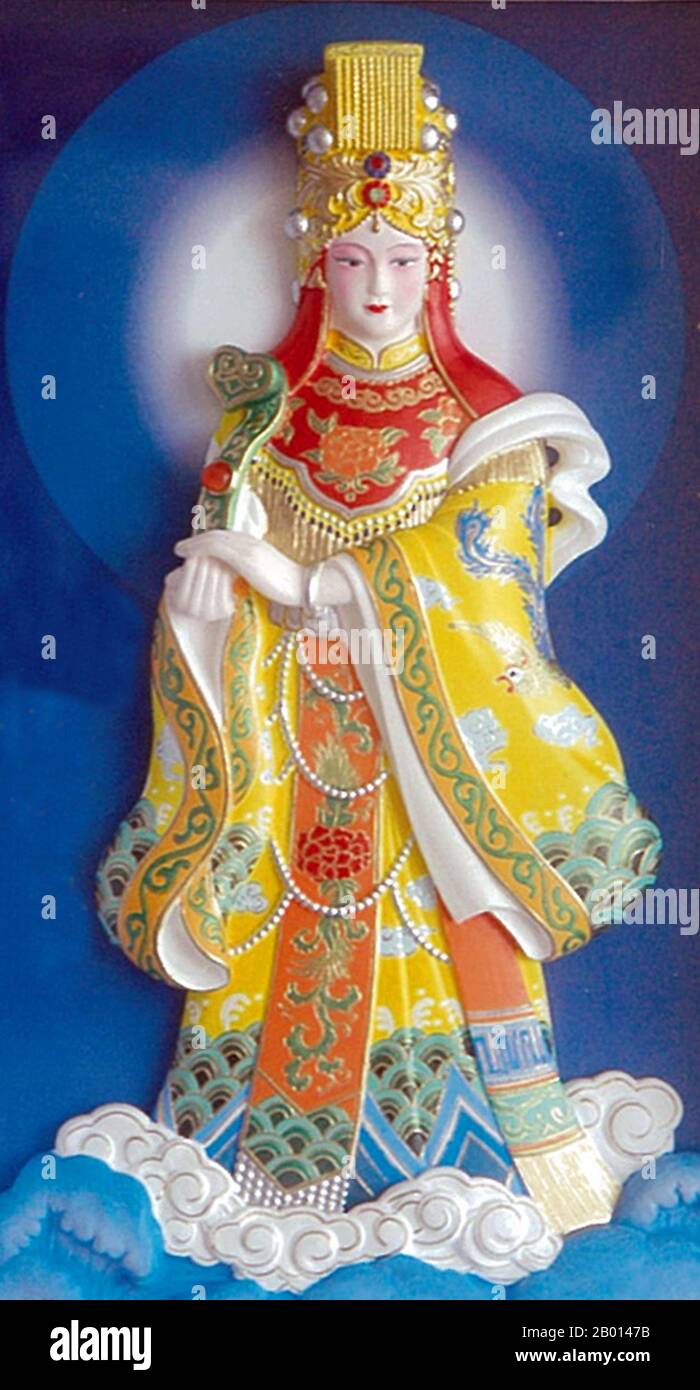 China: Mazu (Matsu) or Tin Hau, the Goddess of the Sea and patron saint of East Asian seafarers. Mazu (Wade–Giles: Matsu, Vietnamese: Ma To) is the indigenous goddess of the sea who is said to protect fishermen and sailors, and is invoked as the patron saint of all Southern Chinese and East Asian persons. Born as Lin Moniang, a shamaness, in Fujian around 960 CE, worship of Mazu began around the Ming Dynasty, when many temples dedicated to her were erected all across Mainland China, later spreading to other countries with Overseas Chinese populations. Stock Photohttps://www.alamy.com/image-license-details/?v=1https://www.alamy.com/china-mazu-matsu-or-tin-hau-the-goddess-of-the-sea-and-patron-saint-of-east-asian-seafarers-mazu-wadegiles-matsu-vietnamese-ma-to-is-the-indigenous-goddess-of-the-sea-who-is-said-to-protect-fishermen-and-sailors-and-is-invoked-as-the-patron-saint-of-all-southern-chinese-and-east-asian-persons-born-as-lin-moniang-a-shamaness-in-fujian-around-960-ce-worship-of-mazu-began-around-the-ming-dynasty-when-many-temples-dedicated-to-her-were-erected-all-across-mainland-china-later-spreading-to-other-countries-with-overseas-chinese-populations-image344232655.html
China: Mazu (Matsu) or Tin Hau, the Goddess of the Sea and patron saint of East Asian seafarers. Mazu (Wade–Giles: Matsu, Vietnamese: Ma To) is the indigenous goddess of the sea who is said to protect fishermen and sailors, and is invoked as the patron saint of all Southern Chinese and East Asian persons. Born as Lin Moniang, a shamaness, in Fujian around 960 CE, worship of Mazu began around the Ming Dynasty, when many temples dedicated to her were erected all across Mainland China, later spreading to other countries with Overseas Chinese populations. Stock Photohttps://www.alamy.com/image-license-details/?v=1https://www.alamy.com/china-mazu-matsu-or-tin-hau-the-goddess-of-the-sea-and-patron-saint-of-east-asian-seafarers-mazu-wadegiles-matsu-vietnamese-ma-to-is-the-indigenous-goddess-of-the-sea-who-is-said-to-protect-fishermen-and-sailors-and-is-invoked-as-the-patron-saint-of-all-southern-chinese-and-east-asian-persons-born-as-lin-moniang-a-shamaness-in-fujian-around-960-ce-worship-of-mazu-began-around-the-ming-dynasty-when-many-temples-dedicated-to-her-were-erected-all-across-mainland-china-later-spreading-to-other-countries-with-overseas-chinese-populations-image344232655.htmlRM2B0147B–China: Mazu (Matsu) or Tin Hau, the Goddess of the Sea and patron saint of East Asian seafarers. Mazu (Wade–Giles: Matsu, Vietnamese: Ma To) is the indigenous goddess of the sea who is said to protect fishermen and sailors, and is invoked as the patron saint of all Southern Chinese and East Asian persons. Born as Lin Moniang, a shamaness, in Fujian around 960 CE, worship of Mazu began around the Ming Dynasty, when many temples dedicated to her were erected all across Mainland China, later spreading to other countries with Overseas Chinese populations.
 (dpa file) A file picture dated 24 October 2008 features a ten-metres tall statue of Taoist goddess Matsu, also known as Tian Hou, in Hong Kong, China. Tian Hou is the Goddess of Sea providing safety for fishermen and seafarers. Photo: Frank Baumgart Stock Photohttps://www.alamy.com/image-license-details/?v=1https://www.alamy.com/stock-photo-dpa-file-a-file-picture-dated-24-october-2008-features-a-ten-metres-54514421.html
(dpa file) A file picture dated 24 October 2008 features a ten-metres tall statue of Taoist goddess Matsu, also known as Tian Hou, in Hong Kong, China. Tian Hou is the Goddess of Sea providing safety for fishermen and seafarers. Photo: Frank Baumgart Stock Photohttps://www.alamy.com/image-license-details/?v=1https://www.alamy.com/stock-photo-dpa-file-a-file-picture-dated-24-october-2008-features-a-ten-metres-54514421.htmlRMD4K9KH–(dpa file) A file picture dated 24 October 2008 features a ten-metres tall statue of Taoist goddess Matsu, also known as Tian Hou, in Hong Kong, China. Tian Hou is the Goddess of Sea providing safety for fishermen and seafarers. Photo: Frank Baumgart
 China: Mazu (Matsu) or Tin Hau, the Goddess of the Sea and patron saint of East Asian seafarers. Mazu (Wade–Giles: Matsu, Vietnamese: Ma To) is the indigenous goddess of the sea who is said to protect fishermen and sailors, and is invoked as the patron saint of all Southern Chinese and East Asian persons. Born as Lin Moniang, a shamaness, in Fujian around 960 CE, worship of Mazu began around the Ming Dynasty, when many temples dedicated to her were erected all across Mainland China, later spreading to other countries with Overseas Chinese populations. Stock Photohttps://www.alamy.com/image-license-details/?v=1https://www.alamy.com/china-mazu-matsu-or-tin-hau-the-goddess-of-the-sea-and-patron-saint-of-east-asian-seafarers-mazu-wadegiles-matsu-vietnamese-ma-to-is-the-indigenous-goddess-of-the-sea-who-is-said-to-protect-fishermen-and-sailors-and-is-invoked-as-the-patron-saint-of-all-southern-chinese-and-east-asian-persons-born-as-lin-moniang-a-shamaness-in-fujian-around-960-ce-worship-of-mazu-began-around-the-ming-dynasty-when-many-temples-dedicated-to-her-were-erected-all-across-mainland-china-later-spreading-to-other-countries-with-overseas-chinese-populations-image344232660.html
China: Mazu (Matsu) or Tin Hau, the Goddess of the Sea and patron saint of East Asian seafarers. Mazu (Wade–Giles: Matsu, Vietnamese: Ma To) is the indigenous goddess of the sea who is said to protect fishermen and sailors, and is invoked as the patron saint of all Southern Chinese and East Asian persons. Born as Lin Moniang, a shamaness, in Fujian around 960 CE, worship of Mazu began around the Ming Dynasty, when many temples dedicated to her were erected all across Mainland China, later spreading to other countries with Overseas Chinese populations. Stock Photohttps://www.alamy.com/image-license-details/?v=1https://www.alamy.com/china-mazu-matsu-or-tin-hau-the-goddess-of-the-sea-and-patron-saint-of-east-asian-seafarers-mazu-wadegiles-matsu-vietnamese-ma-to-is-the-indigenous-goddess-of-the-sea-who-is-said-to-protect-fishermen-and-sailors-and-is-invoked-as-the-patron-saint-of-all-southern-chinese-and-east-asian-persons-born-as-lin-moniang-a-shamaness-in-fujian-around-960-ce-worship-of-mazu-began-around-the-ming-dynasty-when-many-temples-dedicated-to-her-were-erected-all-across-mainland-china-later-spreading-to-other-countries-with-overseas-chinese-populations-image344232660.htmlRM2B0147G–China: Mazu (Matsu) or Tin Hau, the Goddess of the Sea and patron saint of East Asian seafarers. Mazu (Wade–Giles: Matsu, Vietnamese: Ma To) is the indigenous goddess of the sea who is said to protect fishermen and sailors, and is invoked as the patron saint of all Southern Chinese and East Asian persons. Born as Lin Moniang, a shamaness, in Fujian around 960 CE, worship of Mazu began around the Ming Dynasty, when many temples dedicated to her were erected all across Mainland China, later spreading to other countries with Overseas Chinese populations.
 Followers of the goddess Matsu, protector of seafarers and fishermen, prostrate themselves on the ground so that the palanquin carrying a statue of Matsu can pass over them, which is considered by Matsu devotees to bring good fortune. The ritual occurs repeatedly during the nine-day Matsu pilgrimage, which is one of the world's biggest religious festivals and according to the organizers, it attracts about 1 million visitors over the nine days every year. Stock Photohttps://www.alamy.com/image-license-details/?v=1https://www.alamy.com/stock-photo-followers-of-the-goddess-matsu-protector-of-seafarers-and-fishermen-136856296.html
Followers of the goddess Matsu, protector of seafarers and fishermen, prostrate themselves on the ground so that the palanquin carrying a statue of Matsu can pass over them, which is considered by Matsu devotees to bring good fortune. The ritual occurs repeatedly during the nine-day Matsu pilgrimage, which is one of the world's biggest religious festivals and according to the organizers, it attracts about 1 million visitors over the nine days every year. Stock Photohttps://www.alamy.com/image-license-details/?v=1https://www.alamy.com/stock-photo-followers-of-the-goddess-matsu-protector-of-seafarers-and-fishermen-136856296.htmlRMHXJ9GT–Followers of the goddess Matsu, protector of seafarers and fishermen, prostrate themselves on the ground so that the palanquin carrying a statue of Matsu can pass over them, which is considered by Matsu devotees to bring good fortune. The ritual occurs repeatedly during the nine-day Matsu pilgrimage, which is one of the world's biggest religious festivals and according to the organizers, it attracts about 1 million visitors over the nine days every year.
 A lorcha, a three-masted ship with a European-style hull and the sails and rigging of a Chinese junk, depicted in colourful bas-relief on granite boulder before the A-Ma Temple in Macau, China. It represents the vessel of a poor fisherman who carried A-Ma, Taoist mother-goddess and protector of seafarers, to safety after a storm. The temple, dating from 1488 AD, was built where she landed. Stock Photohttps://www.alamy.com/image-license-details/?v=1https://www.alamy.com/a-lorcha-a-three-masted-ship-with-a-european-style-hull-and-the-sails-and-rigging-of-a-chinese-junk-depicted-in-colourful-bas-relief-on-granite-boulder-before-the-a-ma-temple-in-macau-china-it-represents-the-vessel-of-a-poor-fisherman-who-carried-a-ma-taoist-mother-goddess-and-protector-of-seafarers-to-safety-after-a-storm-the-temple-dating-from-1488-ad-was-built-where-she-landed-image545512811.html
A lorcha, a three-masted ship with a European-style hull and the sails and rigging of a Chinese junk, depicted in colourful bas-relief on granite boulder before the A-Ma Temple in Macau, China. It represents the vessel of a poor fisherman who carried A-Ma, Taoist mother-goddess and protector of seafarers, to safety after a storm. The temple, dating from 1488 AD, was built where she landed. Stock Photohttps://www.alamy.com/image-license-details/?v=1https://www.alamy.com/a-lorcha-a-three-masted-ship-with-a-european-style-hull-and-the-sails-and-rigging-of-a-chinese-junk-depicted-in-colourful-bas-relief-on-granite-boulder-before-the-a-ma-temple-in-macau-china-it-represents-the-vessel-of-a-poor-fisherman-who-carried-a-ma-taoist-mother-goddess-and-protector-of-seafarers-to-safety-after-a-storm-the-temple-dating-from-1488-ad-was-built-where-she-landed-image545512811.htmlRF2PKE74B–A lorcha, a three-masted ship with a European-style hull and the sails and rigging of a Chinese junk, depicted in colourful bas-relief on granite boulder before the A-Ma Temple in Macau, China. It represents the vessel of a poor fisherman who carried A-Ma, Taoist mother-goddess and protector of seafarers, to safety after a storm. The temple, dating from 1488 AD, was built where she landed.
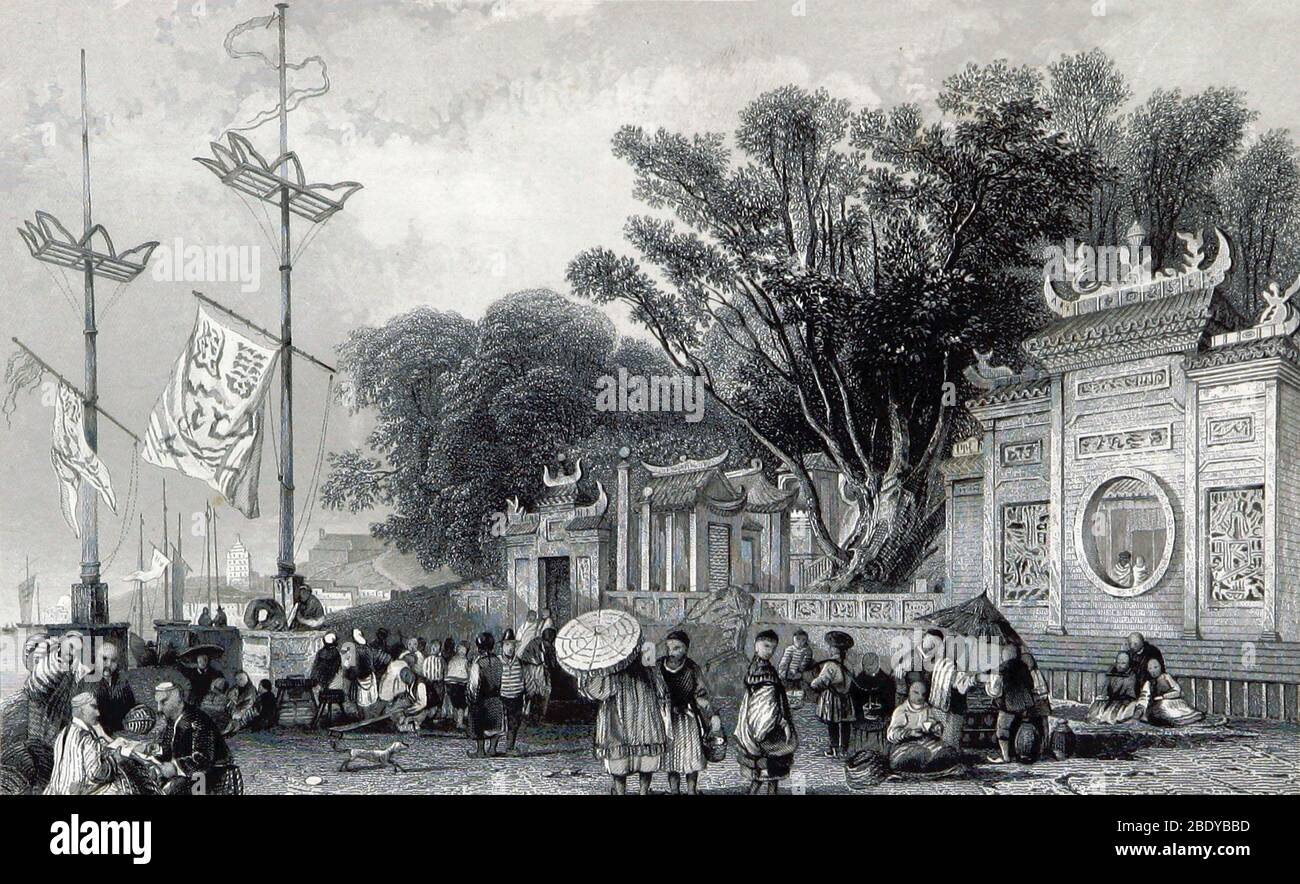 A-Ma Temple, Macau, China, 19th Century Stock Photohttps://www.alamy.com/image-license-details/?v=1https://www.alamy.com/a-ma-temple-macau-china-19th-century-image352799537.html
A-Ma Temple, Macau, China, 19th Century Stock Photohttps://www.alamy.com/image-license-details/?v=1https://www.alamy.com/a-ma-temple-macau-china-19th-century-image352799537.htmlRM2BDYBBD–A-Ma Temple, Macau, China, 19th Century
 Colourful orange gables of Tin Hau chinese temple, Shek O, Hong Kong. Tin Hau is the Chinese Goddess of the Sea, also named Mazu, A-Ma and Tian Fe Stock Photohttps://www.alamy.com/image-license-details/?v=1https://www.alamy.com/colourful-orange-gables-of-tin-hau-chinese-temple-shek-o-hong-kong-tin-hau-is-the-chinese-goddess-of-the-sea-also-named-mazu-a-ma-and-tian-fe-image351401289.html
Colourful orange gables of Tin Hau chinese temple, Shek O, Hong Kong. Tin Hau is the Chinese Goddess of the Sea, also named Mazu, A-Ma and Tian Fe Stock Photohttps://www.alamy.com/image-license-details/?v=1https://www.alamy.com/colourful-orange-gables-of-tin-hau-chinese-temple-shek-o-hong-kong-tin-hau-is-the-chinese-goddess-of-the-sea-also-named-mazu-a-ma-and-tian-fe-image351401289.htmlRF2BBKKX1–Colourful orange gables of Tin Hau chinese temple, Shek O, Hong Kong. Tin Hau is the Chinese Goddess of the Sea, also named Mazu, A-Ma and Tian Fe
 The main gate of the Tian Hou Palace at A-Ma Cultural Village on Coloane Island, Macau Stock Photohttps://www.alamy.com/image-license-details/?v=1https://www.alamy.com/stock-photo-the-main-gate-of-the-tian-hou-palace-at-a-ma-cultural-village-on-coloane-33711392.html
The main gate of the Tian Hou Palace at A-Ma Cultural Village on Coloane Island, Macau Stock Photohttps://www.alamy.com/image-license-details/?v=1https://www.alamy.com/stock-photo-the-main-gate-of-the-tian-hou-palace-at-a-ma-cultural-village-on-coloane-33711392.htmlRMBXRK68–The main gate of the Tian Hou Palace at A-Ma Cultural Village on Coloane Island, Macau
 Wall painting showing the temple of the goddess, Tin Hau, protecting the community from a sea dragon, Stanley, Hong Kong, China Stock Photohttps://www.alamy.com/image-license-details/?v=1https://www.alamy.com/stock-photo-wall-painting-showing-the-temple-of-the-goddess-tin-hau-protecting-27665260.html
Wall painting showing the temple of the goddess, Tin Hau, protecting the community from a sea dragon, Stanley, Hong Kong, China Stock Photohttps://www.alamy.com/image-license-details/?v=1https://www.alamy.com/stock-photo-wall-painting-showing-the-temple-of-the-goddess-tin-hau-protecting-27665260.htmlRMBH0790–Wall painting showing the temple of the goddess, Tin Hau, protecting the community from a sea dragon, Stanley, Hong Kong, China
 (dpa file) A file picture dated 24 October 2008 features a ten-metres tall statue of Taoist goddess Matsu, also known as Tian Hou, in Hong Kong, China. Tian Hou is the Goddess of Sea providing safety for fishermen and seafarers. Photo: Frank Baumgart Stock Photohttps://www.alamy.com/image-license-details/?v=1https://www.alamy.com/stock-photo-dpa-file-a-file-picture-dated-24-october-2008-features-a-ten-metres-54514425.html
(dpa file) A file picture dated 24 October 2008 features a ten-metres tall statue of Taoist goddess Matsu, also known as Tian Hou, in Hong Kong, China. Tian Hou is the Goddess of Sea providing safety for fishermen and seafarers. Photo: Frank Baumgart Stock Photohttps://www.alamy.com/image-license-details/?v=1https://www.alamy.com/stock-photo-dpa-file-a-file-picture-dated-24-october-2008-features-a-ten-metres-54514425.htmlRMD4K9KN–(dpa file) A file picture dated 24 October 2008 features a ten-metres tall statue of Taoist goddess Matsu, also known as Tian Hou, in Hong Kong, China. Tian Hou is the Goddess of Sea providing safety for fishermen and seafarers. Photo: Frank Baumgart
 China: Mazu (Matsu) or Tin Hau, the Goddess of the Sea and patron saint of East Asian seafarers. Mazu (Wade–Giles: Matsu, Vietnamese: Ma To) is the indigenous goddess of the sea who is said to protect fishermen and sailors, and is invoked as the patron saint of all Southern Chinese and East Asian persons. Born as Lin Moniang, a shamaness, in Fujian around 960 CE, worship of Mazu began around the Ming Dynasty, when many temples dedicated to her were erected all across Mainland China, later spreading to other countries with Overseas Chinese populations. Stock Photohttps://www.alamy.com/image-license-details/?v=1https://www.alamy.com/china-mazu-matsu-or-tin-hau-the-goddess-of-the-sea-and-patron-saint-of-east-asian-seafarers-mazu-wadegiles-matsu-vietnamese-ma-to-is-the-indigenous-goddess-of-the-sea-who-is-said-to-protect-fishermen-and-sailors-and-is-invoked-as-the-patron-saint-of-all-southern-chinese-and-east-asian-persons-born-as-lin-moniang-a-shamaness-in-fujian-around-960-ce-worship-of-mazu-began-around-the-ming-dynasty-when-many-temples-dedicated-to-her-were-erected-all-across-mainland-china-later-spreading-to-other-countries-with-overseas-chinese-populations-image344232657.html
China: Mazu (Matsu) or Tin Hau, the Goddess of the Sea and patron saint of East Asian seafarers. Mazu (Wade–Giles: Matsu, Vietnamese: Ma To) is the indigenous goddess of the sea who is said to protect fishermen and sailors, and is invoked as the patron saint of all Southern Chinese and East Asian persons. Born as Lin Moniang, a shamaness, in Fujian around 960 CE, worship of Mazu began around the Ming Dynasty, when many temples dedicated to her were erected all across Mainland China, later spreading to other countries with Overseas Chinese populations. Stock Photohttps://www.alamy.com/image-license-details/?v=1https://www.alamy.com/china-mazu-matsu-or-tin-hau-the-goddess-of-the-sea-and-patron-saint-of-east-asian-seafarers-mazu-wadegiles-matsu-vietnamese-ma-to-is-the-indigenous-goddess-of-the-sea-who-is-said-to-protect-fishermen-and-sailors-and-is-invoked-as-the-patron-saint-of-all-southern-chinese-and-east-asian-persons-born-as-lin-moniang-a-shamaness-in-fujian-around-960-ce-worship-of-mazu-began-around-the-ming-dynasty-when-many-temples-dedicated-to-her-were-erected-all-across-mainland-china-later-spreading-to-other-countries-with-overseas-chinese-populations-image344232657.htmlRM2B0147D–China: Mazu (Matsu) or Tin Hau, the Goddess of the Sea and patron saint of East Asian seafarers. Mazu (Wade–Giles: Matsu, Vietnamese: Ma To) is the indigenous goddess of the sea who is said to protect fishermen and sailors, and is invoked as the patron saint of all Southern Chinese and East Asian persons. Born as Lin Moniang, a shamaness, in Fujian around 960 CE, worship of Mazu began around the Ming Dynasty, when many temples dedicated to her were erected all across Mainland China, later spreading to other countries with Overseas Chinese populations.
 Chiayi County, Taiwan. 27th Mar, 2017. A procession of tens of thousands of followers of the goddess Matsu, protector of seafarers and fishermen, joining the nine-day Dajia Matsu pilgrimage passes through the Chiayi countryside in Southern Taiwan on Monday, March 27. The Matsu pilgrimage is one of the world's biggest religious festivals, and according to the organizers, it attracts about 1 million visitors over the nine days. Credit: Perry Svensson/Alamy News Stock Photohttps://www.alamy.com/image-license-details/?v=1https://www.alamy.com/stock-photo-chiayi-county-taiwan-27th-mar-2017-a-procession-of-tens-of-thousands-136856290.html
Chiayi County, Taiwan. 27th Mar, 2017. A procession of tens of thousands of followers of the goddess Matsu, protector of seafarers and fishermen, joining the nine-day Dajia Matsu pilgrimage passes through the Chiayi countryside in Southern Taiwan on Monday, March 27. The Matsu pilgrimage is one of the world's biggest religious festivals, and according to the organizers, it attracts about 1 million visitors over the nine days. Credit: Perry Svensson/Alamy News Stock Photohttps://www.alamy.com/image-license-details/?v=1https://www.alamy.com/stock-photo-chiayi-county-taiwan-27th-mar-2017-a-procession-of-tens-of-thousands-136856290.htmlRMHXJ9GJ–Chiayi County, Taiwan. 27th Mar, 2017. A procession of tens of thousands of followers of the goddess Matsu, protector of seafarers and fishermen, joining the nine-day Dajia Matsu pilgrimage passes through the Chiayi countryside in Southern Taiwan on Monday, March 27. The Matsu pilgrimage is one of the world's biggest religious festivals, and according to the organizers, it attracts about 1 million visitors over the nine days. Credit: Perry Svensson/Alamy News
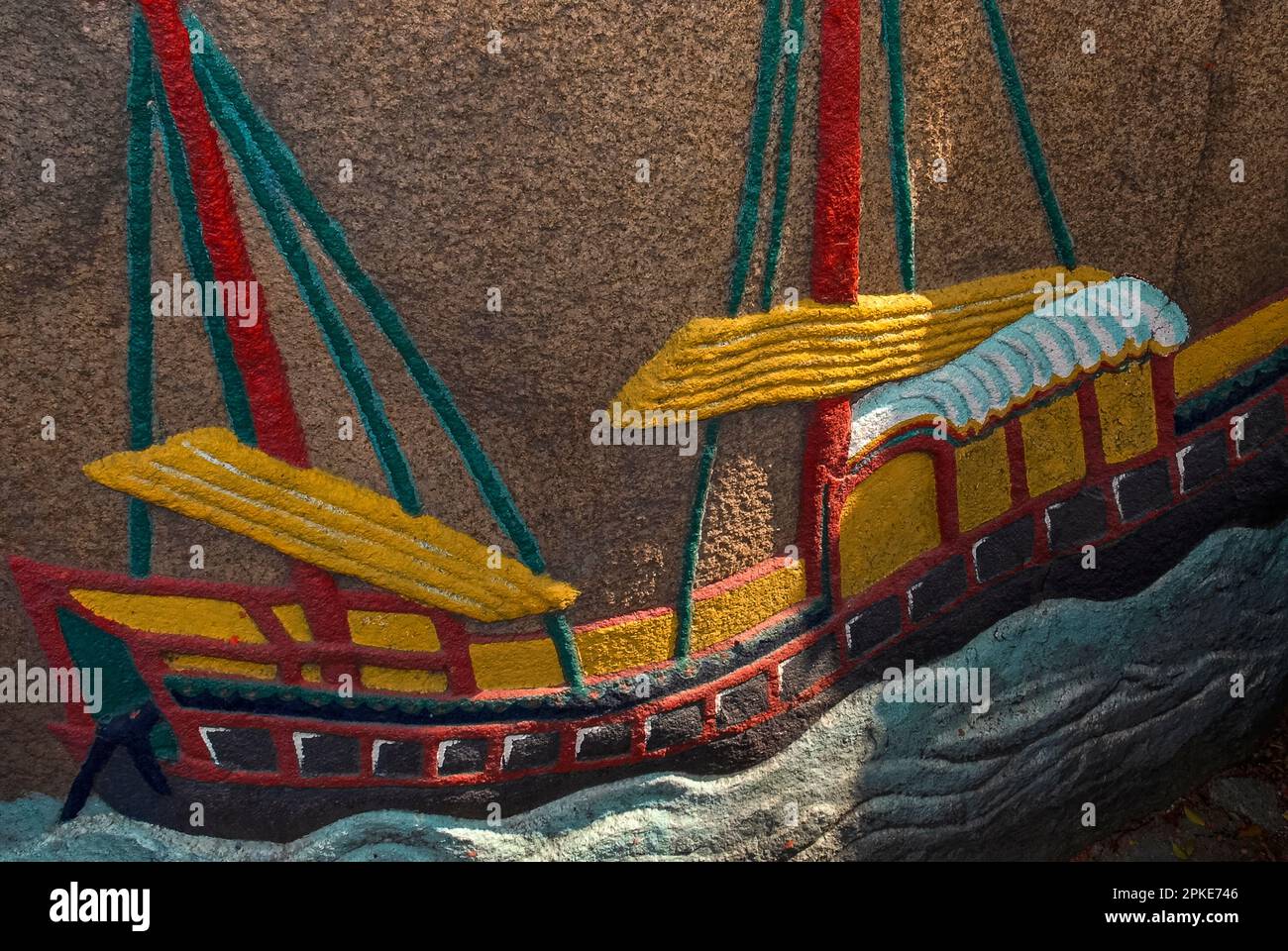 A lorcha, a triple-masted ship with a European hull and the sails and rigging of a Chinese junk, depicted in a colourful bas-relief on a granite boulder before the A-Ma Temple in Macau, China. It represents the vessel of a poor fisherman who carried A-Ma, Taoist mother-goddess and protector of seafarers, to safety after a storm. The temple, dating from 1488 AD, was built on the spot where she landed. Stock Photohttps://www.alamy.com/image-license-details/?v=1https://www.alamy.com/a-lorcha-a-triple-masted-ship-with-a-european-hull-and-the-sails-and-rigging-of-a-chinese-junk-depicted-in-a-colourful-bas-relief-on-a-granite-boulder-before-the-a-ma-temple-in-macau-china-it-represents-the-vessel-of-a-poor-fisherman-who-carried-a-ma-taoist-mother-goddess-and-protector-of-seafarers-to-safety-after-a-storm-the-temple-dating-from-1488-ad-was-built-on-the-spot-where-she-landed-image545512806.html
A lorcha, a triple-masted ship with a European hull and the sails and rigging of a Chinese junk, depicted in a colourful bas-relief on a granite boulder before the A-Ma Temple in Macau, China. It represents the vessel of a poor fisherman who carried A-Ma, Taoist mother-goddess and protector of seafarers, to safety after a storm. The temple, dating from 1488 AD, was built on the spot where she landed. Stock Photohttps://www.alamy.com/image-license-details/?v=1https://www.alamy.com/a-lorcha-a-triple-masted-ship-with-a-european-hull-and-the-sails-and-rigging-of-a-chinese-junk-depicted-in-a-colourful-bas-relief-on-a-granite-boulder-before-the-a-ma-temple-in-macau-china-it-represents-the-vessel-of-a-poor-fisherman-who-carried-a-ma-taoist-mother-goddess-and-protector-of-seafarers-to-safety-after-a-storm-the-temple-dating-from-1488-ad-was-built-on-the-spot-where-she-landed-image545512806.htmlRF2PKE746–A lorcha, a triple-masted ship with a European hull and the sails and rigging of a Chinese junk, depicted in a colourful bas-relief on a granite boulder before the A-Ma Temple in Macau, China. It represents the vessel of a poor fisherman who carried A-Ma, Taoist mother-goddess and protector of seafarers, to safety after a storm. The temple, dating from 1488 AD, was built on the spot where she landed.
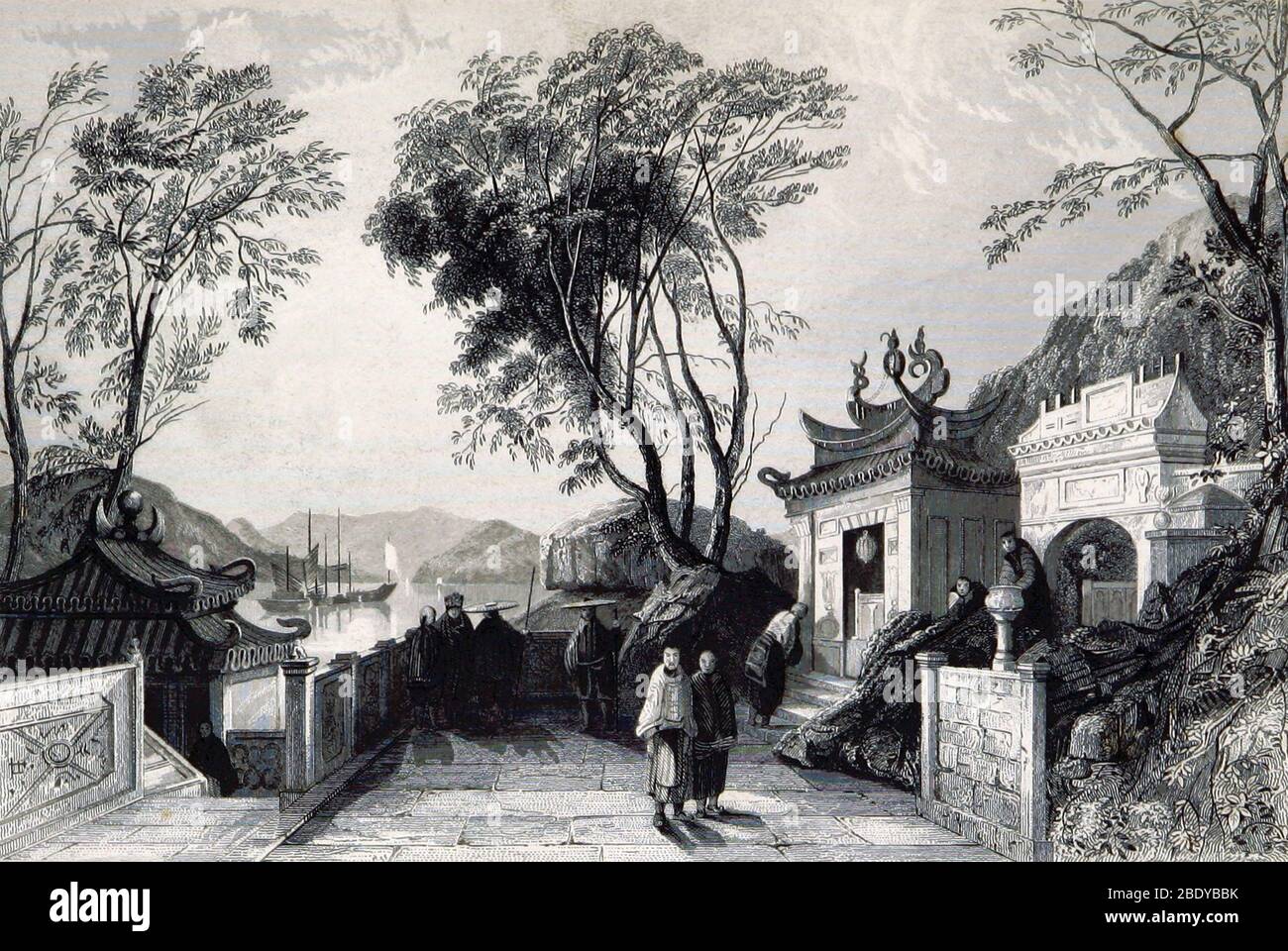 A-Ma Temple, Macau, China, 19th Century Stock Photohttps://www.alamy.com/image-license-details/?v=1https://www.alamy.com/a-ma-temple-macau-china-19th-century-image352799543.html
A-Ma Temple, Macau, China, 19th Century Stock Photohttps://www.alamy.com/image-license-details/?v=1https://www.alamy.com/a-ma-temple-macau-china-19th-century-image352799543.htmlRM2BDYBBK–A-Ma Temple, Macau, China, 19th Century
 Incense sticks burning in the temple at A-Ma Cultural Village on Coloane Island Stock Photohttps://www.alamy.com/image-license-details/?v=1https://www.alamy.com/stock-photo-incense-sticks-burning-in-the-temple-at-a-ma-cultural-village-on-coloane-33711395.html
Incense sticks burning in the temple at A-Ma Cultural Village on Coloane Island Stock Photohttps://www.alamy.com/image-license-details/?v=1https://www.alamy.com/stock-photo-incense-sticks-burning-in-the-temple-at-a-ma-cultural-village-on-coloane-33711395.htmlRMBXRK6B–Incense sticks burning in the temple at A-Ma Cultural Village on Coloane Island
 Colourful wall painting, at Stanley Plaza, of a sea dragon approaching the Tin Hau Temple, Stanley, Hong Kong, China Stock Photohttps://www.alamy.com/image-license-details/?v=1https://www.alamy.com/stock-photo-colourful-wall-painting-at-stanley-plaza-of-a-sea-dragon-approaching-27665228.html
Colourful wall painting, at Stanley Plaza, of a sea dragon approaching the Tin Hau Temple, Stanley, Hong Kong, China Stock Photohttps://www.alamy.com/image-license-details/?v=1https://www.alamy.com/stock-photo-colourful-wall-painting-at-stanley-plaza-of-a-sea-dragon-approaching-27665228.htmlRMBH077T–Colourful wall painting, at Stanley Plaza, of a sea dragon approaching the Tin Hau Temple, Stanley, Hong Kong, China
 China: Mazu (Matsu) or Tin Hau, the Goddess of the Sea and patron saint of East Asian seafarers. Mazu (Wade–Giles: Matsu, Vietnamese: Ma To) is the indigenous goddess of the sea who is said to protect fishermen and sailors, and is invoked as the patron saint of all Southern Chinese and East Asian persons. Born as Lin Moniang, a shamaness, in Fujian around 960 CE, worship of Mazu began around the Ming Dynasty, when many temples dedicated to her were erected all across Mainland China, later spreading to other countries with Overseas Chinese populations. Stock Photohttps://www.alamy.com/image-license-details/?v=1https://www.alamy.com/china-mazu-matsu-or-tin-hau-the-goddess-of-the-sea-and-patron-saint-of-east-asian-seafarers-mazu-wadegiles-matsu-vietnamese-ma-to-is-the-indigenous-goddess-of-the-sea-who-is-said-to-protect-fishermen-and-sailors-and-is-invoked-as-the-patron-saint-of-all-southern-chinese-and-east-asian-persons-born-as-lin-moniang-a-shamaness-in-fujian-around-960-ce-worship-of-mazu-began-around-the-ming-dynasty-when-many-temples-dedicated-to-her-were-erected-all-across-mainland-china-later-spreading-to-other-countries-with-overseas-chinese-populations-image344232659.html
China: Mazu (Matsu) or Tin Hau, the Goddess of the Sea and patron saint of East Asian seafarers. Mazu (Wade–Giles: Matsu, Vietnamese: Ma To) is the indigenous goddess of the sea who is said to protect fishermen and sailors, and is invoked as the patron saint of all Southern Chinese and East Asian persons. Born as Lin Moniang, a shamaness, in Fujian around 960 CE, worship of Mazu began around the Ming Dynasty, when many temples dedicated to her were erected all across Mainland China, later spreading to other countries with Overseas Chinese populations. Stock Photohttps://www.alamy.com/image-license-details/?v=1https://www.alamy.com/china-mazu-matsu-or-tin-hau-the-goddess-of-the-sea-and-patron-saint-of-east-asian-seafarers-mazu-wadegiles-matsu-vietnamese-ma-to-is-the-indigenous-goddess-of-the-sea-who-is-said-to-protect-fishermen-and-sailors-and-is-invoked-as-the-patron-saint-of-all-southern-chinese-and-east-asian-persons-born-as-lin-moniang-a-shamaness-in-fujian-around-960-ce-worship-of-mazu-began-around-the-ming-dynasty-when-many-temples-dedicated-to-her-were-erected-all-across-mainland-china-later-spreading-to-other-countries-with-overseas-chinese-populations-image344232659.htmlRM2B0147F–China: Mazu (Matsu) or Tin Hau, the Goddess of the Sea and patron saint of East Asian seafarers. Mazu (Wade–Giles: Matsu, Vietnamese: Ma To) is the indigenous goddess of the sea who is said to protect fishermen and sailors, and is invoked as the patron saint of all Southern Chinese and East Asian persons. Born as Lin Moniang, a shamaness, in Fujian around 960 CE, worship of Mazu began around the Ming Dynasty, when many temples dedicated to her were erected all across Mainland China, later spreading to other countries with Overseas Chinese populations.
 Chiayi County, Taiwan. 27th Mar, 2017. A procession of followers of the goddess Matsu, protector of seafarers and fishermen, joining the nine-day Dajia Matsu pilgrimage passes through the Chiayi countryside in Southern Taiwan on Monday, March 27. The Matsu pilgrimage is one of the world's biggest religious festivals, and according to the organizers, about 1 million people participate in the pilgrimage over the nine days. Credit: Perry Svensson/Alamy News Stock Photohttps://www.alamy.com/image-license-details/?v=1https://www.alamy.com/stock-photo-chiayi-county-taiwan-27th-mar-2017-a-procession-of-followers-of-the-136856294.html
Chiayi County, Taiwan. 27th Mar, 2017. A procession of followers of the goddess Matsu, protector of seafarers and fishermen, joining the nine-day Dajia Matsu pilgrimage passes through the Chiayi countryside in Southern Taiwan on Monday, March 27. The Matsu pilgrimage is one of the world's biggest religious festivals, and according to the organizers, about 1 million people participate in the pilgrimage over the nine days. Credit: Perry Svensson/Alamy News Stock Photohttps://www.alamy.com/image-license-details/?v=1https://www.alamy.com/stock-photo-chiayi-county-taiwan-27th-mar-2017-a-procession-of-followers-of-the-136856294.htmlRMHXJ9GP–Chiayi County, Taiwan. 27th Mar, 2017. A procession of followers of the goddess Matsu, protector of seafarers and fishermen, joining the nine-day Dajia Matsu pilgrimage passes through the Chiayi countryside in Southern Taiwan on Monday, March 27. The Matsu pilgrimage is one of the world's biggest religious festivals, and according to the organizers, about 1 million people participate in the pilgrimage over the nine days. Credit: Perry Svensson/Alamy News
 China: Mazu (Matsu) or Tin Hau, the Goddess of the Sea and patron saint of East Asian seafarers. Mazu (Wade–Giles: Matsu, Vietnamese: Ma To) is the indigenous goddess of the sea who is said to protect fishermen and sailors, and is invoked as the patron saint of all Southern Chinese and East Asian persons. Born as Lin Moniang, a shamaness, in Fujian around 960 CE, worship of Mazu began around the Ming Dynasty, when many temples dedicated to her were erected all across Mainland China, later spreading to other countries with Overseas Chinese populations. Stock Photohttps://www.alamy.com/image-license-details/?v=1https://www.alamy.com/china-mazu-matsu-or-tin-hau-the-goddess-of-the-sea-and-patron-saint-of-east-asian-seafarers-mazu-wadegiles-matsu-vietnamese-ma-to-is-the-indigenous-goddess-of-the-sea-who-is-said-to-protect-fishermen-and-sailors-and-is-invoked-as-the-patron-saint-of-all-southern-chinese-and-east-asian-persons-born-as-lin-moniang-a-shamaness-in-fujian-around-960-ce-worship-of-mazu-began-around-the-ming-dynasty-when-many-temples-dedicated-to-her-were-erected-all-across-mainland-china-later-spreading-to-other-countries-with-overseas-chinese-populations-image344232656.html
China: Mazu (Matsu) or Tin Hau, the Goddess of the Sea and patron saint of East Asian seafarers. Mazu (Wade–Giles: Matsu, Vietnamese: Ma To) is the indigenous goddess of the sea who is said to protect fishermen and sailors, and is invoked as the patron saint of all Southern Chinese and East Asian persons. Born as Lin Moniang, a shamaness, in Fujian around 960 CE, worship of Mazu began around the Ming Dynasty, when many temples dedicated to her were erected all across Mainland China, later spreading to other countries with Overseas Chinese populations. Stock Photohttps://www.alamy.com/image-license-details/?v=1https://www.alamy.com/china-mazu-matsu-or-tin-hau-the-goddess-of-the-sea-and-patron-saint-of-east-asian-seafarers-mazu-wadegiles-matsu-vietnamese-ma-to-is-the-indigenous-goddess-of-the-sea-who-is-said-to-protect-fishermen-and-sailors-and-is-invoked-as-the-patron-saint-of-all-southern-chinese-and-east-asian-persons-born-as-lin-moniang-a-shamaness-in-fujian-around-960-ce-worship-of-mazu-began-around-the-ming-dynasty-when-many-temples-dedicated-to-her-were-erected-all-across-mainland-china-later-spreading-to-other-countries-with-overseas-chinese-populations-image344232656.htmlRM2B0147C–China: Mazu (Matsu) or Tin Hau, the Goddess of the Sea and patron saint of East Asian seafarers. Mazu (Wade–Giles: Matsu, Vietnamese: Ma To) is the indigenous goddess of the sea who is said to protect fishermen and sailors, and is invoked as the patron saint of all Southern Chinese and East Asian persons. Born as Lin Moniang, a shamaness, in Fujian around 960 CE, worship of Mazu began around the Ming Dynasty, when many temples dedicated to her were erected all across Mainland China, later spreading to other countries with Overseas Chinese populations.
 A lorcha, a three-masted ship with a European-style hull and the sails and rigging of a Chinese junk, depicted in colourful bas-relief on pink granite boulder by entrance to A-Ma Temple in Macau, China. It represents the vessel of a poor fisherman who carried A-Ma, Taoist mother-goddess and protector of seafarers, to safety after a storm. The temple, dating from 1488 AD, was built where she landed. Stock Photohttps://www.alamy.com/image-license-details/?v=1https://www.alamy.com/a-lorcha-a-three-masted-ship-with-a-european-style-hull-and-the-sails-and-rigging-of-a-chinese-junk-depicted-in-colourful-bas-relief-on-pink-granite-boulder-by-entrance-to-a-ma-temple-in-macau-china-it-represents-the-vessel-of-a-poor-fisherman-who-carried-a-ma-taoist-mother-goddess-and-protector-of-seafarers-to-safety-after-a-storm-the-temple-dating-from-1488-ad-was-built-where-she-landed-image545512818.html
A lorcha, a three-masted ship with a European-style hull and the sails and rigging of a Chinese junk, depicted in colourful bas-relief on pink granite boulder by entrance to A-Ma Temple in Macau, China. It represents the vessel of a poor fisherman who carried A-Ma, Taoist mother-goddess and protector of seafarers, to safety after a storm. The temple, dating from 1488 AD, was built where she landed. Stock Photohttps://www.alamy.com/image-license-details/?v=1https://www.alamy.com/a-lorcha-a-three-masted-ship-with-a-european-style-hull-and-the-sails-and-rigging-of-a-chinese-junk-depicted-in-colourful-bas-relief-on-pink-granite-boulder-by-entrance-to-a-ma-temple-in-macau-china-it-represents-the-vessel-of-a-poor-fisherman-who-carried-a-ma-taoist-mother-goddess-and-protector-of-seafarers-to-safety-after-a-storm-the-temple-dating-from-1488-ad-was-built-where-she-landed-image545512818.htmlRF2PKE74J–A lorcha, a three-masted ship with a European-style hull and the sails and rigging of a Chinese junk, depicted in colourful bas-relief on pink granite boulder by entrance to A-Ma Temple in Macau, China. It represents the vessel of a poor fisherman who carried A-Ma, Taoist mother-goddess and protector of seafarers, to safety after a storm. The temple, dating from 1488 AD, was built where she landed.
 China: Mazu (Matsu) or Tin Hau, the Goddess of the Sea and patron saint of seafarers. Illustration, c. 19th century. Mazu (Wade–Giles: Matsu, Vietnamese: Ma To) is the indigenous goddess of the sea who is said to protect fishermen and sailors, and is invoked as the patron saint of all Southern Chinese and East Asian persons. Born as Lin Moniang, a shamaness, in Fujian around 960 CE, worship of Mazu began around the Ming Dynasty, when many temples dedicated to her were erected all across Mainland China, later spreading to other countries with Overseas Chinese populations. Stock Photohttps://www.alamy.com/image-license-details/?v=1https://www.alamy.com/china-mazu-matsu-or-tin-hau-the-goddess-of-the-sea-and-patron-saint-of-seafarers-illustration-c-19th-century-mazu-wadegiles-matsu-vietnamese-ma-to-is-the-indigenous-goddess-of-the-sea-who-is-said-to-protect-fishermen-and-sailors-and-is-invoked-as-the-patron-saint-of-all-southern-chinese-and-east-asian-persons-born-as-lin-moniang-a-shamaness-in-fujian-around-960-ce-worship-of-mazu-began-around-the-ming-dynasty-when-many-temples-dedicated-to-her-were-erected-all-across-mainland-china-later-spreading-to-other-countries-with-overseas-chinese-populations-image344232654.html
China: Mazu (Matsu) or Tin Hau, the Goddess of the Sea and patron saint of seafarers. Illustration, c. 19th century. Mazu (Wade–Giles: Matsu, Vietnamese: Ma To) is the indigenous goddess of the sea who is said to protect fishermen and sailors, and is invoked as the patron saint of all Southern Chinese and East Asian persons. Born as Lin Moniang, a shamaness, in Fujian around 960 CE, worship of Mazu began around the Ming Dynasty, when many temples dedicated to her were erected all across Mainland China, later spreading to other countries with Overseas Chinese populations. Stock Photohttps://www.alamy.com/image-license-details/?v=1https://www.alamy.com/china-mazu-matsu-or-tin-hau-the-goddess-of-the-sea-and-patron-saint-of-seafarers-illustration-c-19th-century-mazu-wadegiles-matsu-vietnamese-ma-to-is-the-indigenous-goddess-of-the-sea-who-is-said-to-protect-fishermen-and-sailors-and-is-invoked-as-the-patron-saint-of-all-southern-chinese-and-east-asian-persons-born-as-lin-moniang-a-shamaness-in-fujian-around-960-ce-worship-of-mazu-began-around-the-ming-dynasty-when-many-temples-dedicated-to-her-were-erected-all-across-mainland-china-later-spreading-to-other-countries-with-overseas-chinese-populations-image344232654.htmlRM2B0147A–China: Mazu (Matsu) or Tin Hau, the Goddess of the Sea and patron saint of seafarers. Illustration, c. 19th century. Mazu (Wade–Giles: Matsu, Vietnamese: Ma To) is the indigenous goddess of the sea who is said to protect fishermen and sailors, and is invoked as the patron saint of all Southern Chinese and East Asian persons. Born as Lin Moniang, a shamaness, in Fujian around 960 CE, worship of Mazu began around the Ming Dynasty, when many temples dedicated to her were erected all across Mainland China, later spreading to other countries with Overseas Chinese populations.
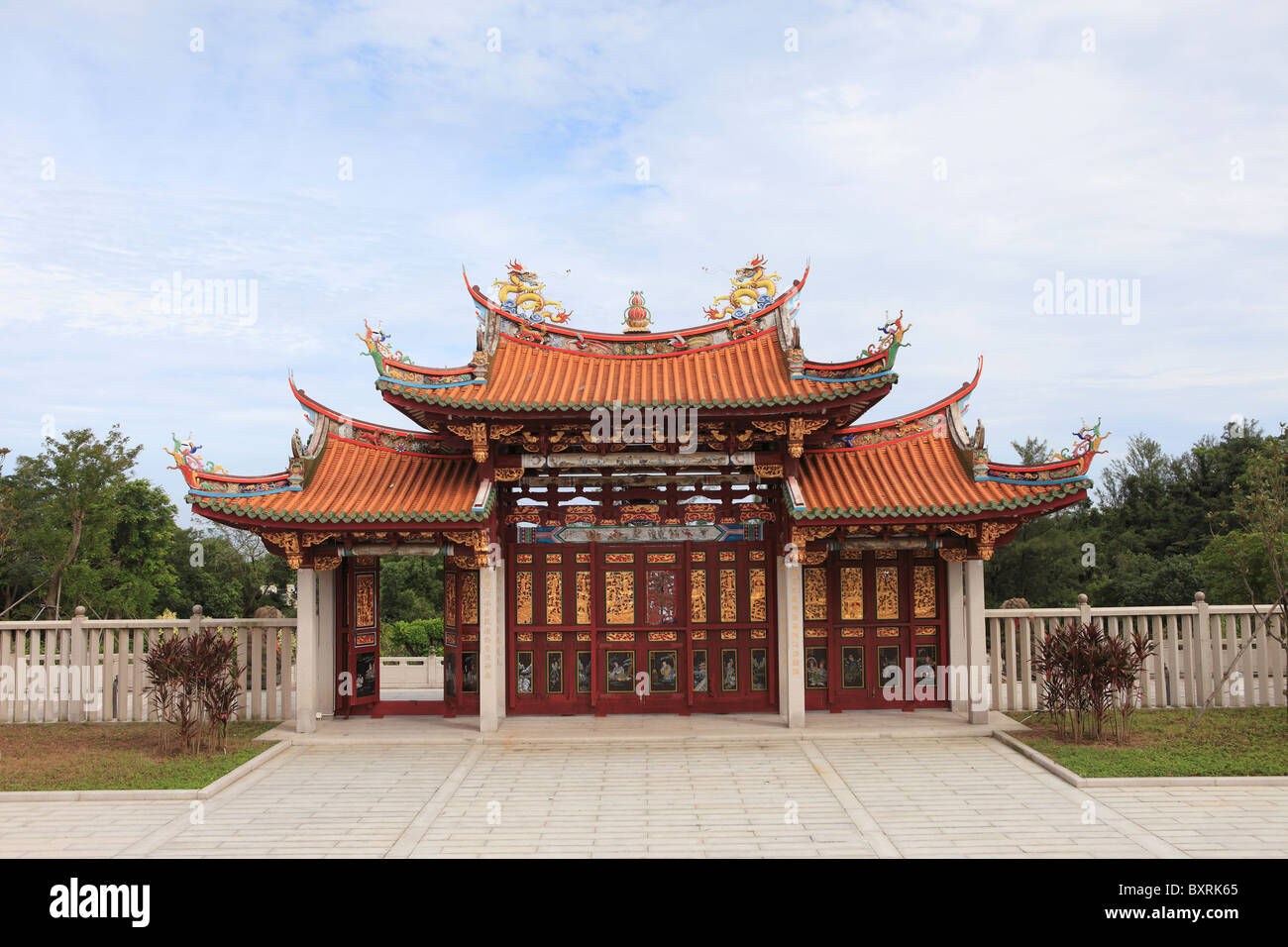 The main gate of the Tian Hou Palace at A-Ma Cultural Village on Coloane Island, Macau Stock Photohttps://www.alamy.com/image-license-details/?v=1https://www.alamy.com/stock-photo-the-main-gate-of-the-tian-hou-palace-at-a-ma-cultural-village-on-coloane-33711389.html
The main gate of the Tian Hou Palace at A-Ma Cultural Village on Coloane Island, Macau Stock Photohttps://www.alamy.com/image-license-details/?v=1https://www.alamy.com/stock-photo-the-main-gate-of-the-tian-hou-palace-at-a-ma-cultural-village-on-coloane-33711389.htmlRMBXRK65–The main gate of the Tian Hou Palace at A-Ma Cultural Village on Coloane Island, Macau
 Oblique view of the front of the Tin Hau Temple, with incense burner and stone lions, Main Street, Stanley, Hong Kong, China Stock Photohttps://www.alamy.com/image-license-details/?v=1https://www.alamy.com/stock-photo-oblique-view-of-the-front-of-the-tin-hau-temple-with-incense-burner-27665304.html
Oblique view of the front of the Tin Hau Temple, with incense burner and stone lions, Main Street, Stanley, Hong Kong, China Stock Photohttps://www.alamy.com/image-license-details/?v=1https://www.alamy.com/stock-photo-oblique-view-of-the-front-of-the-tin-hau-temple-with-incense-burner-27665304.htmlRMBH07AG–Oblique view of the front of the Tin Hau Temple, with incense burner and stone lions, Main Street, Stanley, Hong Kong, China
 Thousands of Matsu followers are gathered in front of Fengtian Temple in Hsingang Township in southern Taiwan on Tuesday, March 28, for the Matsu blessing ceremony that is part of the nine-day pilgrimage that brings the statue of the goddess Matsu — protector of seafarers and fishermen — from Chenlan Temple in Dajia Township, Taichung, to Hsingang and back. The Matsu pilgrimage is one of the world's biggest religious festivals, and according to the organizers, about 1 million people participate over the nine days every year. Stock Photohttps://www.alamy.com/image-license-details/?v=1https://www.alamy.com/stock-photo-thousands-of-matsu-followers-are-gathered-in-front-of-fengtian-temple-136856298.html
Thousands of Matsu followers are gathered in front of Fengtian Temple in Hsingang Township in southern Taiwan on Tuesday, March 28, for the Matsu blessing ceremony that is part of the nine-day pilgrimage that brings the statue of the goddess Matsu — protector of seafarers and fishermen — from Chenlan Temple in Dajia Township, Taichung, to Hsingang and back. The Matsu pilgrimage is one of the world's biggest religious festivals, and according to the organizers, about 1 million people participate over the nine days every year. Stock Photohttps://www.alamy.com/image-license-details/?v=1https://www.alamy.com/stock-photo-thousands-of-matsu-followers-are-gathered-in-front-of-fengtian-temple-136856298.htmlRMHXJ9GX–Thousands of Matsu followers are gathered in front of Fengtian Temple in Hsingang Township in southern Taiwan on Tuesday, March 28, for the Matsu blessing ceremony that is part of the nine-day pilgrimage that brings the statue of the goddess Matsu — protector of seafarers and fishermen — from Chenlan Temple in Dajia Township, Taichung, to Hsingang and back. The Matsu pilgrimage is one of the world's biggest religious festivals, and according to the organizers, about 1 million people participate over the nine days every year.
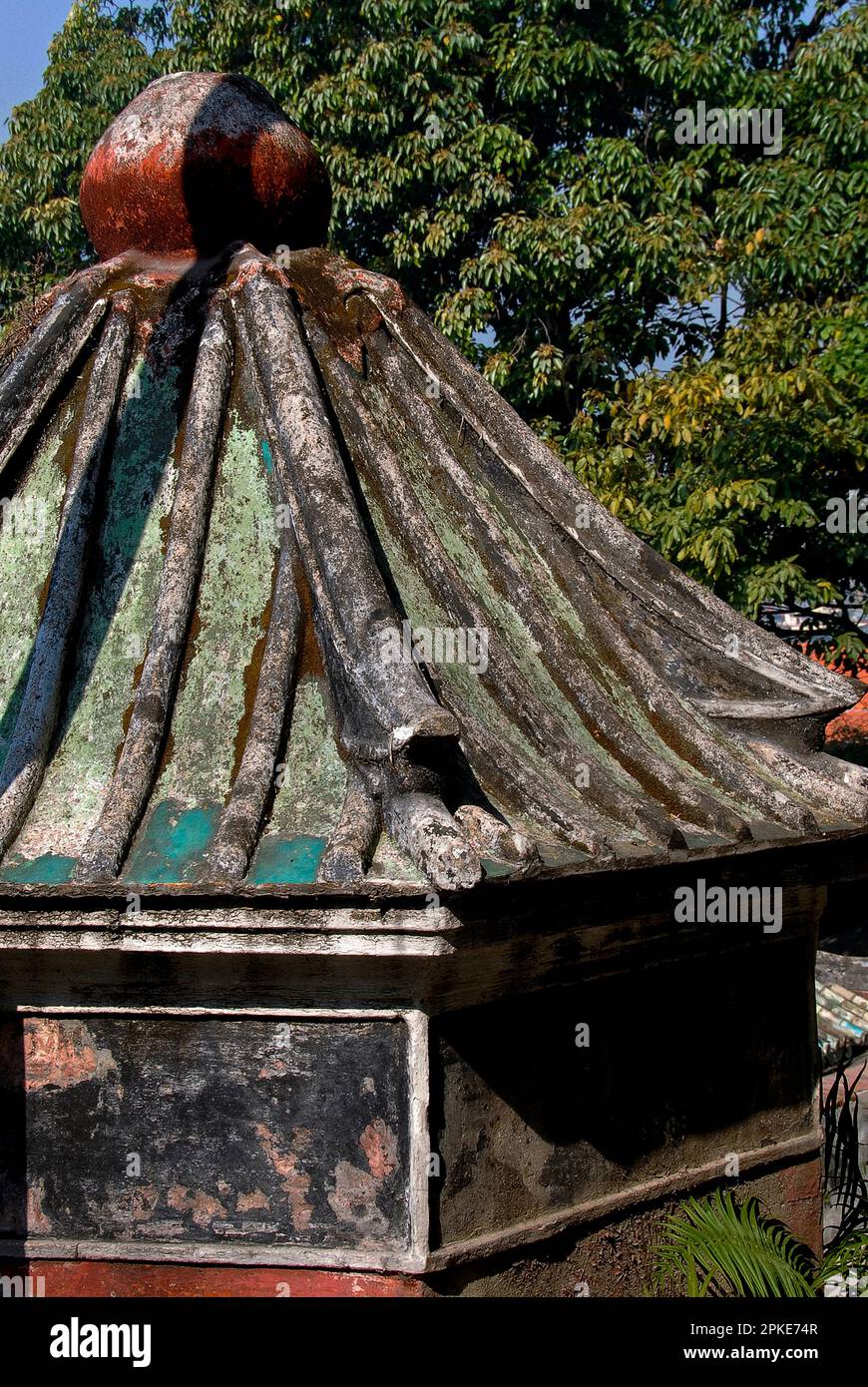 Weathered traditional curving roof of small pavilion amid buildings on the site of the A-Ma Temple at the entrance to the Inner Harbour in Macau, China. The temple, dating from 1488 AD, was built where A-Ma or Tin Hau, Taoist mother-goddess and protector of seafarers, landed safely in a fishing boat after a storm, before she ascended to heaven from the top of nearby Barra Hill. Stock Photohttps://www.alamy.com/image-license-details/?v=1https://www.alamy.com/weathered-traditional-curving-roof-of-small-pavilion-amid-buildings-on-the-site-of-the-a-ma-temple-at-the-entrance-to-the-inner-harbour-in-macau-china-the-temple-dating-from-1488-ad-was-built-where-a-ma-or-tin-hau-taoist-mother-goddess-and-protector-of-seafarers-landed-safely-in-a-fishing-boat-after-a-storm-before-she-ascended-to-heaven-from-the-top-of-nearby-barra-hill-image545512823.html
Weathered traditional curving roof of small pavilion amid buildings on the site of the A-Ma Temple at the entrance to the Inner Harbour in Macau, China. The temple, dating from 1488 AD, was built where A-Ma or Tin Hau, Taoist mother-goddess and protector of seafarers, landed safely in a fishing boat after a storm, before she ascended to heaven from the top of nearby Barra Hill. Stock Photohttps://www.alamy.com/image-license-details/?v=1https://www.alamy.com/weathered-traditional-curving-roof-of-small-pavilion-amid-buildings-on-the-site-of-the-a-ma-temple-at-the-entrance-to-the-inner-harbour-in-macau-china-the-temple-dating-from-1488-ad-was-built-where-a-ma-or-tin-hau-taoist-mother-goddess-and-protector-of-seafarers-landed-safely-in-a-fishing-boat-after-a-storm-before-she-ascended-to-heaven-from-the-top-of-nearby-barra-hill-image545512823.htmlRF2PKE74R–Weathered traditional curving roof of small pavilion amid buildings on the site of the A-Ma Temple at the entrance to the Inner Harbour in Macau, China. The temple, dating from 1488 AD, was built where A-Ma or Tin Hau, Taoist mother-goddess and protector of seafarers, landed safely in a fishing boat after a storm, before she ascended to heaven from the top of nearby Barra Hill.
 China: Mazu (Matsu) or Tin Hau, the Goddess of the Sea and patron saint of seafarers. Hanging scroll painting, c. 18th-19th century. Mazu (Wade–Giles: Matsu, Vietnamese: Ma To) is the indigenous goddess of the sea who is said to protect fishermen and sailors, and is invoked as the patron saint of all Southern Chinese and East Asian persons. Born as Lin Moniang, a shamaness, in Fujian around 960 CE, worship of Mazu began around the Ming Dynasty, when many temples dedicated to her were erected all across Mainland China, later spreading to other countries with Overseas Chinese populations. Stock Photohttps://www.alamy.com/image-license-details/?v=1https://www.alamy.com/china-mazu-matsu-or-tin-hau-the-goddess-of-the-sea-and-patron-saint-of-seafarers-hanging-scroll-painting-c-18th-19th-century-mazu-wadegiles-matsu-vietnamese-ma-to-is-the-indigenous-goddess-of-the-sea-who-is-said-to-protect-fishermen-and-sailors-and-is-invoked-as-the-patron-saint-of-all-southern-chinese-and-east-asian-persons-born-as-lin-moniang-a-shamaness-in-fujian-around-960-ce-worship-of-mazu-began-around-the-ming-dynasty-when-many-temples-dedicated-to-her-were-erected-all-across-mainland-china-later-spreading-to-other-countries-with-overseas-chinese-populations-image344232653.html
China: Mazu (Matsu) or Tin Hau, the Goddess of the Sea and patron saint of seafarers. Hanging scroll painting, c. 18th-19th century. Mazu (Wade–Giles: Matsu, Vietnamese: Ma To) is the indigenous goddess of the sea who is said to protect fishermen and sailors, and is invoked as the patron saint of all Southern Chinese and East Asian persons. Born as Lin Moniang, a shamaness, in Fujian around 960 CE, worship of Mazu began around the Ming Dynasty, when many temples dedicated to her were erected all across Mainland China, later spreading to other countries with Overseas Chinese populations. Stock Photohttps://www.alamy.com/image-license-details/?v=1https://www.alamy.com/china-mazu-matsu-or-tin-hau-the-goddess-of-the-sea-and-patron-saint-of-seafarers-hanging-scroll-painting-c-18th-19th-century-mazu-wadegiles-matsu-vietnamese-ma-to-is-the-indigenous-goddess-of-the-sea-who-is-said-to-protect-fishermen-and-sailors-and-is-invoked-as-the-patron-saint-of-all-southern-chinese-and-east-asian-persons-born-as-lin-moniang-a-shamaness-in-fujian-around-960-ce-worship-of-mazu-began-around-the-ming-dynasty-when-many-temples-dedicated-to-her-were-erected-all-across-mainland-china-later-spreading-to-other-countries-with-overseas-chinese-populations-image344232653.htmlRM2B01479–China: Mazu (Matsu) or Tin Hau, the Goddess of the Sea and patron saint of seafarers. Hanging scroll painting, c. 18th-19th century. Mazu (Wade–Giles: Matsu, Vietnamese: Ma To) is the indigenous goddess of the sea who is said to protect fishermen and sailors, and is invoked as the patron saint of all Southern Chinese and East Asian persons. Born as Lin Moniang, a shamaness, in Fujian around 960 CE, worship of Mazu began around the Ming Dynasty, when many temples dedicated to her were erected all across Mainland China, later spreading to other countries with Overseas Chinese populations.
 Incense sticks burning in the temple at A-Ma Cultural Village on Coloane Island Stock Photohttps://www.alamy.com/image-license-details/?v=1https://www.alamy.com/stock-photo-incense-sticks-burning-in-the-temple-at-a-ma-cultural-village-on-coloane-33711400.html
Incense sticks burning in the temple at A-Ma Cultural Village on Coloane Island Stock Photohttps://www.alamy.com/image-license-details/?v=1https://www.alamy.com/stock-photo-incense-sticks-burning-in-the-temple-at-a-ma-cultural-village-on-coloane-33711400.htmlRMBXRK6G–Incense sticks burning in the temple at A-Ma Cultural Village on Coloane Island
 Frontal view, with incense burner and stone lions, of the Tin Hau Temple, Main Street, Stanley, Hong Kong, China Stock Photohttps://www.alamy.com/image-license-details/?v=1https://www.alamy.com/stock-photo-frontal-view-with-incense-burner-and-stone-lions-of-the-tin-hau-temple-27665282.html
Frontal view, with incense burner and stone lions, of the Tin Hau Temple, Main Street, Stanley, Hong Kong, China Stock Photohttps://www.alamy.com/image-license-details/?v=1https://www.alamy.com/stock-photo-frontal-view-with-incense-burner-and-stone-lions-of-the-tin-hau-temple-27665282.htmlRMBH079P–Frontal view, with incense burner and stone lions, of the Tin Hau Temple, Main Street, Stanley, Hong Kong, China
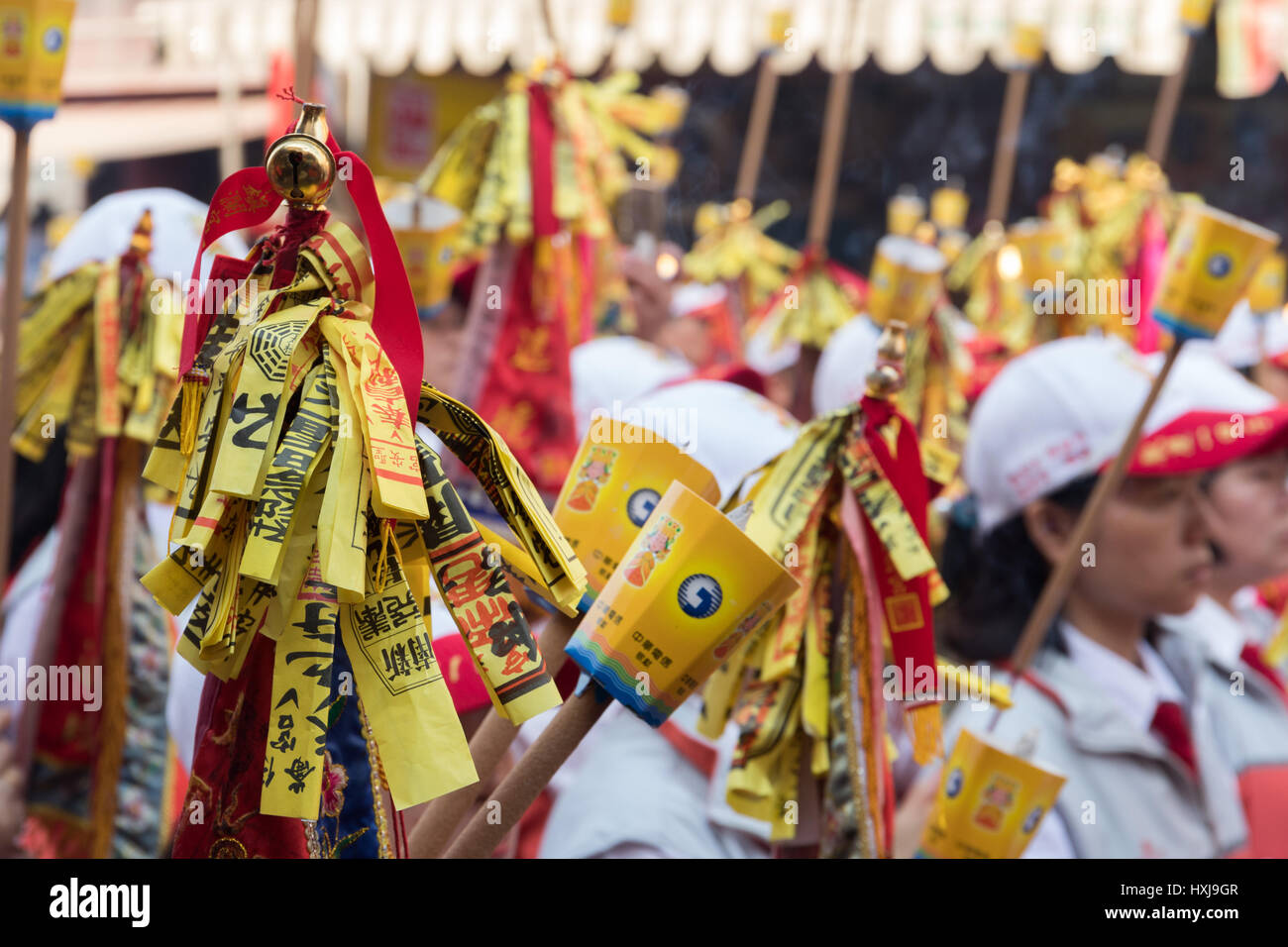 Hsingang, Taiwan. 28th Mar, 2017. Followers of the goddess Matsu, protector of seafarers and fishermen, hold flags with paper talismans collected at the temples they pass during the nine-day Matsu pilgrimage as they attend the Matsu blessing ceremony at Fengtian Temple in Hsingang in southern Taiwan on March 28. According to the organizers, the Matsu pilgrimage is one of the world's biggest religious festivals and attracts about 1 million participants over the nine days every year. Credit: Perry Svensson/Alamy News Stock Photohttps://www.alamy.com/image-license-details/?v=1https://www.alamy.com/stock-photo-hsingang-taiwan-28th-mar-2017-followers-of-the-goddess-matsu-protector-136856295.html
Hsingang, Taiwan. 28th Mar, 2017. Followers of the goddess Matsu, protector of seafarers and fishermen, hold flags with paper talismans collected at the temples they pass during the nine-day Matsu pilgrimage as they attend the Matsu blessing ceremony at Fengtian Temple in Hsingang in southern Taiwan on March 28. According to the organizers, the Matsu pilgrimage is one of the world's biggest religious festivals and attracts about 1 million participants over the nine days every year. Credit: Perry Svensson/Alamy News Stock Photohttps://www.alamy.com/image-license-details/?v=1https://www.alamy.com/stock-photo-hsingang-taiwan-28th-mar-2017-followers-of-the-goddess-matsu-protector-136856295.htmlRMHXJ9GR–Hsingang, Taiwan. 28th Mar, 2017. Followers of the goddess Matsu, protector of seafarers and fishermen, hold flags with paper talismans collected at the temples they pass during the nine-day Matsu pilgrimage as they attend the Matsu blessing ceremony at Fengtian Temple in Hsingang in southern Taiwan on March 28. According to the organizers, the Matsu pilgrimage is one of the world's biggest religious festivals and attracts about 1 million participants over the nine days every year. Credit: Perry Svensson/Alamy News
 Graceful flying eves decorated in black and white curve upward over ridges of green semicircular ceramic tiles on a typical traditional roof over a pavilion of the A-Ma Temple in Macau, China. The temple, dating from 1488 AD, stands where A-Ma or Tin Hau, Taoist mother-goddess and protector of seafarers, landed safely in a fishing boat after a storm before she ascended to heaven. Stock Photohttps://www.alamy.com/image-license-details/?v=1https://www.alamy.com/graceful-flying-eves-decorated-in-black-and-white-curve-upward-over-ridges-of-green-semicircular-ceramic-tiles-on-a-typical-traditional-roof-over-a-pavilion-of-the-a-ma-temple-in-macau-china-the-temple-dating-from-1488-ad-stands-where-a-ma-or-tin-hau-taoist-mother-goddess-and-protector-of-seafarers-landed-safely-in-a-fishing-boat-after-a-storm-before-she-ascended-to-heaven-image545512874.html
Graceful flying eves decorated in black and white curve upward over ridges of green semicircular ceramic tiles on a typical traditional roof over a pavilion of the A-Ma Temple in Macau, China. The temple, dating from 1488 AD, stands where A-Ma or Tin Hau, Taoist mother-goddess and protector of seafarers, landed safely in a fishing boat after a storm before she ascended to heaven. Stock Photohttps://www.alamy.com/image-license-details/?v=1https://www.alamy.com/graceful-flying-eves-decorated-in-black-and-white-curve-upward-over-ridges-of-green-semicircular-ceramic-tiles-on-a-typical-traditional-roof-over-a-pavilion-of-the-a-ma-temple-in-macau-china-the-temple-dating-from-1488-ad-stands-where-a-ma-or-tin-hau-taoist-mother-goddess-and-protector-of-seafarers-landed-safely-in-a-fishing-boat-after-a-storm-before-she-ascended-to-heaven-image545512874.htmlRF2PKE76J–Graceful flying eves decorated in black and white curve upward over ridges of green semicircular ceramic tiles on a typical traditional roof over a pavilion of the A-Ma Temple in Macau, China. The temple, dating from 1488 AD, stands where A-Ma or Tin Hau, Taoist mother-goddess and protector of seafarers, landed safely in a fishing boat after a storm before she ascended to heaven.
 One of the temple buildings at A-Ma Cultural Village on Coloane Island, Macau Stock Photohttps://www.alamy.com/image-license-details/?v=1https://www.alamy.com/stock-photo-one-of-the-temple-buildings-at-a-ma-cultural-village-on-coloane-island-33711377.html
One of the temple buildings at A-Ma Cultural Village on Coloane Island, Macau Stock Photohttps://www.alamy.com/image-license-details/?v=1https://www.alamy.com/stock-photo-one-of-the-temple-buildings-at-a-ma-cultural-village-on-coloane-island-33711377.htmlRMBXRK5N–One of the temple buildings at A-Ma Cultural Village on Coloane Island, Macau
 Graceful curved flying eves decorated in black and white sweep upward over ridges of green semicircular ceramic tiles on a typical traditional roof over a pavilion of the A-Ma Temple in Macau, China. The temple, dating from 1488 AD, stands where A-Ma or Tin Hau, Taoist mother-goddess and protector of seafarers, landed safely in a fishing boat after a storm before she ascended to heaven. Stock Photohttps://www.alamy.com/image-license-details/?v=1https://www.alamy.com/graceful-curved-flying-eves-decorated-in-black-and-white-sweep-upward-over-ridges-of-green-semicircular-ceramic-tiles-on-a-typical-traditional-roof-over-a-pavilion-of-the-a-ma-temple-in-macau-china-the-temple-dating-from-1488-ad-stands-where-a-ma-or-tin-hau-taoist-mother-goddess-and-protector-of-seafarers-landed-safely-in-a-fishing-boat-after-a-storm-before-she-ascended-to-heaven-image545512825.html
Graceful curved flying eves decorated in black and white sweep upward over ridges of green semicircular ceramic tiles on a typical traditional roof over a pavilion of the A-Ma Temple in Macau, China. The temple, dating from 1488 AD, stands where A-Ma or Tin Hau, Taoist mother-goddess and protector of seafarers, landed safely in a fishing boat after a storm before she ascended to heaven. Stock Photohttps://www.alamy.com/image-license-details/?v=1https://www.alamy.com/graceful-curved-flying-eves-decorated-in-black-and-white-sweep-upward-over-ridges-of-green-semicircular-ceramic-tiles-on-a-typical-traditional-roof-over-a-pavilion-of-the-a-ma-temple-in-macau-china-the-temple-dating-from-1488-ad-stands-where-a-ma-or-tin-hau-taoist-mother-goddess-and-protector-of-seafarers-landed-safely-in-a-fishing-boat-after-a-storm-before-she-ascended-to-heaven-image545512825.htmlRF2PKE74W–Graceful curved flying eves decorated in black and white sweep upward over ridges of green semicircular ceramic tiles on a typical traditional roof over a pavilion of the A-Ma Temple in Macau, China. The temple, dating from 1488 AD, stands where A-Ma or Tin Hau, Taoist mother-goddess and protector of seafarers, landed safely in a fishing boat after a storm before she ascended to heaven.
 The main gate of the Tian Hou Palace at A-Ma Cultural Village on Coloane Island, Macau Stock Photohttps://www.alamy.com/image-license-details/?v=1https://www.alamy.com/stock-photo-the-main-gate-of-the-tian-hou-palace-at-a-ma-cultural-village-on-coloane-33711385.html
The main gate of the Tian Hou Palace at A-Ma Cultural Village on Coloane Island, Macau Stock Photohttps://www.alamy.com/image-license-details/?v=1https://www.alamy.com/stock-photo-the-main-gate-of-the-tian-hou-palace-at-a-ma-cultural-village-on-coloane-33711385.htmlRMBXRK61–The main gate of the Tian Hou Palace at A-Ma Cultural Village on Coloane Island, Macau
 The main gate of the Tian Hou Palace at A-Ma Cultural Village on Coloane Island, Macau Stock Photohttps://www.alamy.com/image-license-details/?v=1https://www.alamy.com/stock-photo-the-main-gate-of-the-tian-hou-palace-at-a-ma-cultural-village-on-coloane-33711381.html
The main gate of the Tian Hou Palace at A-Ma Cultural Village on Coloane Island, Macau Stock Photohttps://www.alamy.com/image-license-details/?v=1https://www.alamy.com/stock-photo-the-main-gate-of-the-tian-hou-palace-at-a-ma-cultural-village-on-coloane-33711381.htmlRMBXRK5W–The main gate of the Tian Hou Palace at A-Ma Cultural Village on Coloane Island, Macau